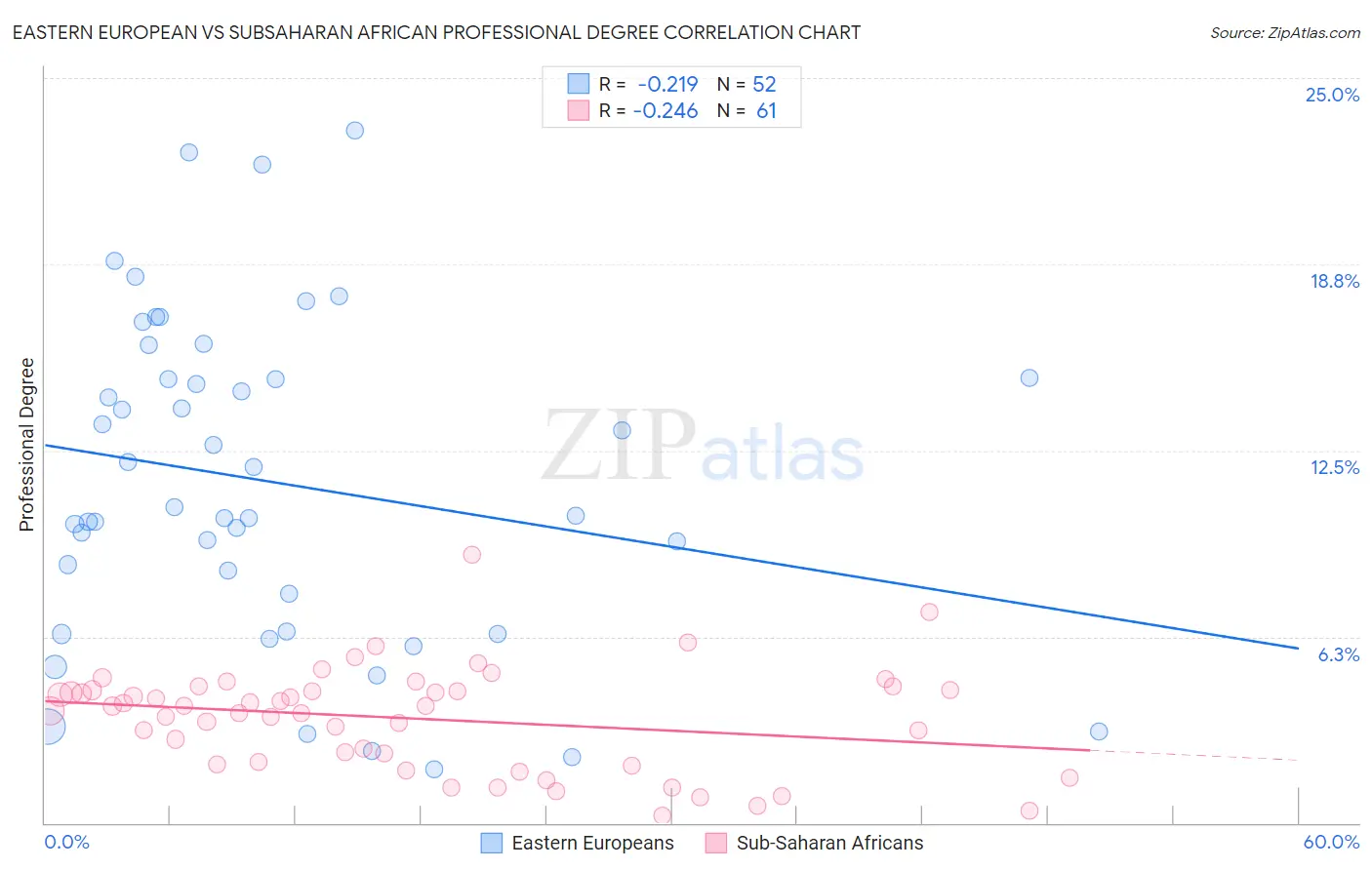Eastern European vs Subsaharan African Professional Degree
COMPARE
Eastern European
Subsaharan African
Professional Degree
Professional Degree Comparison
Eastern Europeans
Sub-Saharan Africans
7.1%
PROFESSIONAL DEGREE
100.0/ 100
METRIC RATING
7th/ 347
METRIC RANK
4.1%
PROFESSIONAL DEGREE
12.8/ 100
METRIC RATING
207th/ 347
METRIC RANK
Eastern European vs Subsaharan African Professional Degree Correlation Chart
The statistical analysis conducted on geographies consisting of 459,646,077 people shows a weak negative correlation between the proportion of Eastern Europeans and percentage of population with at least professional degree education in the United States with a correlation coefficient (R) of -0.219 and weighted average of 7.1%. Similarly, the statistical analysis conducted on geographies consisting of 505,148,465 people shows a weak negative correlation between the proportion of Sub-Saharan Africans and percentage of population with at least professional degree education in the United States with a correlation coefficient (R) of -0.246 and weighted average of 4.1%, a difference of 73.1%.

Professional Degree Correlation Summary
| Measurement | Eastern European | Subsaharan African |
| Minimum | 1.8% | 0.23% |
| Maximum | 23.2% | 9.0% |
| Range | 21.4% | 8.8% |
| Mean | 11.4% | 3.5% |
| Median | 10.5% | 3.9% |
| Interquartile 25% (IQ1) | 7.1% | 2.0% |
| Interquartile 75% (IQ3) | 14.9% | 4.4% |
| Interquartile Range (IQR) | 7.9% | 2.4% |
| Standard Deviation (Sample) | 5.4% | 1.7% |
| Standard Deviation (Population) | 5.4% | 1.7% |
Similar Demographics by Professional Degree
Demographics Similar to Eastern Europeans by Professional Degree
In terms of professional degree, the demographic groups most similar to Eastern Europeans are Immigrants from Switzerland (7.1%, a difference of 0.14%), Immigrants from Taiwan (7.1%, a difference of 0.33%), Immigrants from Belgium (7.0%, a difference of 2.1%), Cypriot (6.9%, a difference of 2.2%), and Israeli (6.9%, a difference of 2.3%).
| Demographics | Rating | Rank | Professional Degree |
| Immigrants | Israel | 100.0 /100 | #1 | Exceptional 7.9% |
| Immigrants | Singapore | 100.0 /100 | #2 | Exceptional 7.7% |
| Iranians | 100.0 /100 | #3 | Exceptional 7.6% |
| Filipinos | 100.0 /100 | #4 | Exceptional 7.6% |
| Immigrants | Iran | 100.0 /100 | #5 | Exceptional 7.3% |
| Okinawans | 100.0 /100 | #6 | Exceptional 7.3% |
| Eastern Europeans | 100.0 /100 | #7 | Exceptional 7.1% |
| Immigrants | Switzerland | 100.0 /100 | #8 | Exceptional 7.1% |
| Immigrants | Taiwan | 100.0 /100 | #9 | Exceptional 7.1% |
| Immigrants | Belgium | 100.0 /100 | #10 | Exceptional 7.0% |
| Cypriots | 100.0 /100 | #11 | Exceptional 6.9% |
| Israelis | 100.0 /100 | #12 | Exceptional 6.9% |
| Immigrants | Australia | 100.0 /100 | #13 | Exceptional 6.9% |
| Immigrants | France | 100.0 /100 | #14 | Exceptional 6.8% |
| Immigrants | China | 100.0 /100 | #15 | Exceptional 6.7% |
Demographics Similar to Sub-Saharan Africans by Professional Degree
In terms of professional degree, the demographic groups most similar to Sub-Saharan Africans are Immigrants from Somalia (4.1%, a difference of 0.080%), Immigrants from Panama (4.1%, a difference of 0.16%), Yugoslavian (4.1%, a difference of 0.24%), Immigrants from Nigeria (4.1%, a difference of 0.38%), and German (4.1%, a difference of 0.42%).
| Demographics | Rating | Rank | Professional Degree |
| Immigrants | North Macedonia | 20.2 /100 | #200 | Fair 4.2% |
| Finns | 18.7 /100 | #201 | Poor 4.2% |
| Immigrants | Iraq | 17.1 /100 | #202 | Poor 4.2% |
| Panamanians | 15.9 /100 | #203 | Poor 4.1% |
| Barbadians | 15.8 /100 | #204 | Poor 4.1% |
| Somalis | 14.8 /100 | #205 | Poor 4.1% |
| Yugoslavians | 13.4 /100 | #206 | Poor 4.1% |
| Sub-Saharan Africans | 12.8 /100 | #207 | Poor 4.1% |
| Immigrants | Somalia | 12.5 /100 | #208 | Poor 4.1% |
| Immigrants | Panama | 12.3 /100 | #209 | Poor 4.1% |
| Immigrants | Nigeria | 11.7 /100 | #210 | Poor 4.1% |
| Germans | 11.6 /100 | #211 | Poor 4.1% |
| Whites/Caucasians | 11.2 /100 | #212 | Poor 4.1% |
| Koreans | 10.7 /100 | #213 | Poor 4.1% |
| Immigrants | Ghana | 10.6 /100 | #214 | Poor 4.1% |